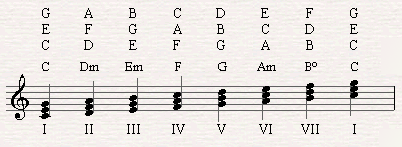
They’re often labeled with “aug” and the number of the interval. They’re just less common.Īugmented intervals are perfect or major intervals raised by one-half step. But there will be times you’ll use augmented and diminished intervals too. Most of the chords you’ll build will use perfect, major and minor piano intervals to build the chords. This interval is the distance between the keynote of a major scale and the seventh note of the scale, but lowered one-half step. The label “m7” on another black key represents a “minor seventh” interval. This interval is the distance between the keynote of a major scale and the sixth note of the scale, but lowered one-half step. The label “m6” on another black key represents a “minor sixth” interval. This interval is the distance between the keynote of a major scale and the third note of the scale, but lowered one-half step. The label “m3” on the second black key represents a “minor third” interval. It’s the distance between the keynote of a major scale and the second note of the scale, but lowered one-half step. The label “m2” on the first black key represents a “minor second” interval. These represent minor intervals, one half-step below major intervals. You’ll notice on the graphic there are some black keys with lower-case “m’s” and numbers on them. Learn about half-steps and whole-steps here. Minor intervals are major intervals lowered by a half-step. This interval is the distance between the keynote of a major scale and the seventh note of the scale. This stands for a “Major Seventh” interval. The seventh note of the scale has an “M7” on it. This interval is the distance between the keynote of a major scale and the sixth note of the scale. This stands for a “Major Sixth” interval. The sixth note of the scale has an “M6” on it. This interval is the distance between the keynote of a major scale and the third note of the scale. This stands for a “Major Third” interval. The third note of the scale has an “M3” on it. This interval is the distance between the keynote of a major scale and the second note of the scale. This stands for a “Major Second” interval. If we look at the graphic, we see”M2″ on the second note of the scale.

Major intervals are the intervals between the keynote of a major scale and the second, third, sixth and seventh notes of the scale. This interval is the distance between the keynote of a major scale and the eighth/final note of the scale. This stands for a “Perfect 8th” interval, also known as an “Octave”. This interval is the distance between the keynote of a major scale and the fifth note of the scale. This stands for a “Perfect 5th” interval. This interval is the distance between the keynote of a major scale and the fourth note of the scale. This stands for a “Perfect 4th” interval. The fourth note on the graphic has a “P4” on it. This interval is the distance between the keynote of a major scale and the first note of the scale - the same note. That “P1” stands for a “Perfect 1st” interval, also known as a “Unison”. If we look at the graphic, we can see the keynote C (the starting note of the scale) has a “P1” on it. Perfect intervals are the intervals between the keynote of a major scale and the first, fourth, fifth and eighth notes of the scale. So what do these letter/number labels mean? Well, let’s define the five types of piano intervals. But to summarize, a major scale is built using a pattern of whole and half-steps (W – W – H – W – W – W – H).

#The note c on piano how to
If you’re not sure how to build a major scale, you can learn that here. (If you’re wondering whether we should count the black keys when we count intervals, great question! We’ll look at that in a minute.) Interval TypesĪbove is a picture of a C major scale (the white keys only). A C to an E is an interval of a third, and a C to an F is an interval of a fourth.

We label the interval a “second” because we label it by the number of the upper note.

Intervals are distances between notes, counted from low to high, labeled by the number of the upper note.įor example, a C to a D is an interval of a second, because a C to a D is a distance of two notes alphabetically.


 0 kommentar(er)
0 kommentar(er)
